A new collection of videos and photographs show the current state of HMS Glasgow as the Type 26 Frigate is being built by BAE Systems on the River Clyde in Glasgow.
HMS GLASGOW is the first in a new generation of cutting-edge Type 26 frigates, designed and built in the ship’s namesake city.
You can view the previous drone imagery from earlier in the year by clicking here but if you’ve seen that, here’s today’s video!
The Type 26 frigate is an advanced anti-submarine warship, which will deliver critical protection of the Royal Navy’s ‘Continuous At Sea Deterrent’ and Carrier Strike Groups. The ships will replace the UK’s Type 23 frigates, with the first set to enter service in the mid-2020s.
According to BAE:
“Each Type 26 will be equipped with a range of systems including the Sea Ceptor missile defence system, a 5-inch medium calibre gun, flexible mission bay, Artisan 997 Medium Range Radar, and towed array sonars. The flight deck will be able to accommodate helicopters up to the size of a Chinook, while the mission bay can quickly adapt to house and deploy vessels, vehicles and containers.”
The forward and stern sections of HMS Glasgow were rolled out in April and were joined together at the yard last year, work has advanced rapidly since then with the mast and other components fitted as you’ll see in the video.
Actually, rather than me going on about the ship, here’s the video…
Here are the photos, just click to enlarge them.
[su_custom_gallery source=”media: 40496,40498,40500,40501,40502,40503,40495″ limit=”30″ link=”image” width=”200″ height=”130″ title=”never”]
What next for the frigate?
The vessel will be moved onto a submersible barge towards the end of this year, the barge will then travel down the Clyde to Glen Mallan in the Firth of Clyde where the barge will be lowered into the deep water.
The frigate will then be towed back up the Clyde to Scotstoun where she will be fitted out before undertaking sea trials over the next few years.



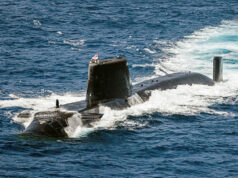

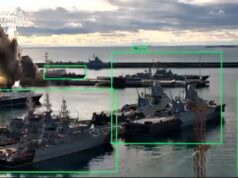
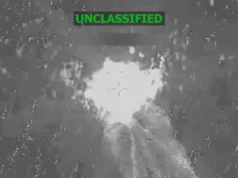

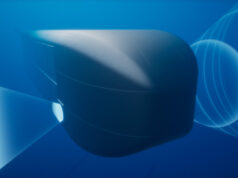
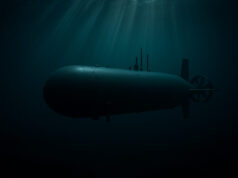



I see the fierce Scottish summer weather requires the ship to be all wrapped up!
The Covering is too keep those bloody Midges from biting the Welders argh the Scottish summer and all its delights Andrew
ineed wee beasties, would keep the russians away, give them a uniform
We could but Putin would claim Biological warfare he is whiter than white in his actions he would never do anything so annoying 🪲🪲🪲🪲 but it would be fun
It’s the ultimate stealth coating
I did wonder how they were going
to get her into the water, then read the text down the page after the video had finished!
I understand that it’s being put on a barge and I’m guessing the barge sinks down river and the ship floats off. How are they getting it off the concrete and onto the barge is what I don’t understand yet. Does the ship need to move over to the ramp? Is the barge on wheels? Is it on a foundation and the barge is strapped round it and driven off the wall? Im totally unable to figure it out.
The ship itself will likely have a self-propelled modular transporter (SPMT) positioned underneath her. When fitted, they’ll rotate and move the ship onto the barge. When the ship is correctly positioned and secured on the launching barge, the SPMT will be removed, allowing the barge to be towed for launching.
SPMTs have been used by the shipyard in the past. Type 26 ships are currently constructed in three main hull blocks (front, middle, arse); they were used to move the blocks into position for joining. They were also employed to then move the two halves of the ship onto the hardstanding for joining and further assembly.
The Rivers were also loaded onto barges using SPMTs.
So similar to how they did Stonehenge 😉
In The Day they had sheds built over slipways for big yachts if not ships. Expensive but So much simpler. What happened to our minds?
I didn’t know they had self driving vehicles when Stonehenge was erected😂😂😂😂😂
Not self driving, self propelled 🙈
I see. So drive the ship onto a barge that’s in the water. I’ve seen driving an astute onto the ship lift at barrow. For some reason my brain couldn’t get to grips with how it works at govan. It must be a really stable barge to be able to drive the ship onto it. Good luck to them when the time comes.
There is something special about sliding a ship down the ramp and it splashing into the water held back by huge chains. Would love to see it in person.
It’ll take a lot of time, caution and the work of experienced tug crews. The barge will likely be placed just off her bow (that’s where the barge was positioned for the Rivers). from looking at the photos, it will be a tight squeeze!
Yes, it’s a similar to the system used for Astutes, although they use rails and metal wheels rather than the units used at Govan. I can imagine T31 will use the same method as T26 for launch/fit out.
Agree on the launches!
I think the barge is actually partly “dived” like a submarine, and as the ship drives on to it, the necessary sections are carefully “surfaced” to provide the additional buoyancy and keep the barge remaining at exactly the same height as the jetty. It’s quite the challenge!
The modern heavy lift barges have very sophisticated software controlled buoyancy trimming to prevent excessive stresses to the hull.
Whist it would be a mistake to say it was fully automated, tidal interactions will still need Contol as positional stability cannot be reactive, it isn’t as hard as it would have been 20 years ago.
I just watched HMS forth launch on YouTube. Wow. The barge was really stable. They made it look easy. Very impressed. I wonder what viewing is like on the Clyde. I might pop through to watch it if you can get a good spot opposite the ship yard. Or chuck someone in the high risers £50 to watch from there flat😂😂😂
What’s the Displacement of T26 again guys ?
Its all here https://en.wikipedia.org/wiki/Type_26_frigate
Displacement of 7,800 tonnes. 👍
Video looks so peaceful with hardly a soul in view. Lovely day for drone-flying.
And in-service by 2027, only five years left to wait.
https://commonslibrary.parliament.uk/prime-minister-announces-new-royal-navy-ship-what-is-the-type-32-frigate/
“To ask Her Majesty’s Government, further to the Written Answer by Baroness Goldie on 26 January (HL5599), whether the first Type 26 (1) passed Main Gate in 2015, (2) was ordered July 2017, (3) will enter operational service 2027; and whether they expect the last of the eight ships in that class will enter service in 2041.”
Answered on10 February 2022
“In November 2015 the Strategic Defence and Security Review confirmed that eight Type 26 frigates would be manufactured. In 2016 the Demonstration Phase for the Type 26 frigates was extended to June 2017. A contract for the manufacture of the first batch of three Type 26 frigates was awarded to BAE Systems in June 2017.
All three ships of the first batch of Type 26 frigates are currently in build in Govan, with the first Type 26 frigate (HMS GLASGOW) expected to be in service with the Royal Navy in 2027.
The procurement of the Batch 2 (Ships 4-8) Type 26 frigates was confirmed in 2021 and will be subject to a separate approval and contract, which is expected to be awarded early in the 2020s. The dates for the construction of each ship, and its price, will be set during commercial negotiations with BAES. The in-service dates for the Batch 2 ships will be determined and approved when the programme achieves its main investment decision point.”
https://questions-statements.parliament.uk/written-questions/detail/2022-02-04/HL6009
As it is 2022 and the ship looks almost structurally complete, why will it take another 5 years to become operational? It just appears unnecessarily slow.
It is unlikely it will take that long to be at a very advanced state of trials.
The full in service date has probably got more to do with the number of new, to RN, systems such as 5”, Mk41 and other bits we don’t know about.
The long fit-out phase at Govan has got more to do with making sure the work force is continuously employed.
Imagine we had ordered a cruiser in WW1 in 1917 and the last entered service just in time to join force Z in WW2. I just love how much life has speeded up in the computer age; not. The new Ice Age. We want 8 and we wont wait! Madness.
Pretty much all RN ships spend three years between being launched and being commissioned.
I believe at some point it was said she might be commissioned earlier in 2025 or 2026.
She looks a beauty, I just wish we could build another dozen on top of those ordered.
That’s a bit greeey…lol…even just 1-2 more…but they T31/T32s could be half/third or cheaper for the prices
*greedy.. Lol
I just want to see the end of the decline mate and a reversal of it.
So few countries can build warships of this quality and capability. And at 1.3Bn a pop, they aren’t cheap.
And ?
And. We aren’t going to buy 16 of these things. Be grateful we can build these things at all, because most countries can’t.
Yeah if there was going to be a large surface fleet increase I would say 5 batch 2 T31 or an additional order of T32. Type 32 would really depend on what it ends up being like. This allows the Type 26 and type 45 to focus on dedicated high end roles. Increase the Type31-32 by £100m to fit extra sensors/defences or whatever is needed to be an ok multi role ship. (Sonar, more missiles, helicopters etc). Would probably require an extra 1-2000 personal at a minimum.
Maybe an extra 1-2 type 26 could be ordered if funds were available. Long lead items would most likely need ordered in next few years.
Some people accept mediocracy as a standard, others expect more. I’m firmly in the expecting more camp.
A T26 is not mediocre. nor is the ability to build them or operate them. I’m realistic about what we can afford, and what the defence budget is likely to be considering the current financial climate. We are not going to get 1990’s numbers at today’s prices.
Give me 20 of the Mogami class over 8 T26 any day. We are not going to get 1990s numbers by building cruiser sized vessels, whose range is utterly useless when it is not much more heavily armed.
Which is why we are building T31. And T26 capability is In a different league completely from the Mogami class.
Also worth noting that the JMSDF is only getting 6-8 Mogami’s, not 20.
I haven’t looked for anything official. But 20 does seem a lot for the Japanese.
I believe the order for Mogami’s is 6 firm with an option for 2 more, which frankly I think the Japanese will go for.
With the aim of the build programme stretching till 2032, at a rate of 2 per year,plans change obviously but the figure of 22 is quite realistic.
Steel is cheap and air is free. The size of the City class has a comparatively minor effect on it’s over all cost.
Some people are realistic. Others live in a fantasy world. You’re in the fantasy camp.
Whatever you say petal.
“Petal”? Mate, do I really need to get involved here?
xfgnfsjsyj
Good thing you edited that – You know I can see the previous revision, yeah?
£800m according to BAE a few weeks ago. Excluding R&D and program setup costs.
I’d be more concerned that we could be falling behind. These have no BMD and no hypersonic launch capabilities. If we’re going to spend 1b more on another T26 then I’d rather see that 1b spent on ensuring the next batch is current.
Who knows what hypersonic launch capability looks like?
I’d be surprised if gen1 hypersonic launch wasn’t canister based just until the tech matured you wouldn’t want to build it in unless it fits in a Mk41 VLS.
😍
She is going to be Gorgeous when she is complete.
Can’t wait to see her.
Let’s hope the govt sees the light and starts building more frigates and submarines than planned.
Would also love a fully UK designed and built stealth drone like Taranis.
Ukraine has proved exactly how critical they will be in any future war. The way they have used them to obliterate the Russians is incredible.
But no long range SSM. Despite being flagged as ASW, I find the lack of offensive capability worrying
FC/ASW should include a long range variant from the early 2030s. There’s no reason it couldn’t have one earlier, other than MoD preferring to throw good money after bad rather than supporting success.
We are getting TLAM V anyway. Do they all have to be torpedo tube launched, or might we get some maritime versions and tweak HMS Glasgow’s Mk 41s to accomodate while we are waiting for FC/ASW ?
I believe stocks are around 60 for TLAM so not really worth it to put on the T26.
We could easily buy a dozen more and it wouldn’t cost the £250m that we were going to spend on the more modern “interim” SSGMs. More like £50m when you add in the spares and support. If a maximum of two of the first three frigates are likely to be in dangerous areas at any one time, they could carry six each. Hopefully batch two can take FC/ASW from the off.
That’s what really pisses me off about the MOD, they waste so much money on the National Flagship, Ajax etc, yet when it comes to a really important part of defence they cancel it. I would certainly prefer the interim SSGM as when T23s are decommissioned, it could move onto T31 or potentially even on the Rivers as it is canister launched.
The ones we currently have are designed to be tube launched from our SSN’s, so don’t fit into the Mk 41 Launchers without modification. It would probably be cheaper to purchase new from the USA if we want to put them onto T26’s.
True and true!
It’s a waiting game to see what will go in type 26 mark 41 launchers. 24 cells are In the design.
Would be better to fit the next batch with MAC that the USN will use for long range attack. MAC will most likely become the MK41 for hypersonic missiles.
Who knows until Hypersonic matures a few generations?
That is the current issue: unless there is a crystal ball to hand the best you can do is leave space, top weight and power margin for later upgrades.
Given the international crisis, its surprising that:
1) The build rate isn’t speeded up, a 2027 in service date is frankly ridiculous and reflects badly on the Treasury, MOD and BAE
2) These and T31s aren’t uparmed, I realise that ship launched ASW torpedoes and sonars are a marginal asset, but in war the marginal matters, at the very least they keep a Subnarine at arms length.
3) An interim SSM isn’t sort: surely either a marinised Brimstone or upgraded Harpoon makes sense, as we already have stocks and are familiar with them.
Rec,
if you think the build rate is ridiculous for the type26’s, then it’ll be even worse for the future destroyers!
Does that mean the last T23 will be decommissioned in 2041? I cant wait to see it cause I’ll likely have passed over! Who is kidding who? I think they are hoping it will all be drones by then.
No, HMS London’s In Service Date is predicted to be 2035. But even then the last Type 23 has to go out of service before HMS London enters service or there will be a lack of systems to migrate and crew to train on her.
Unfortunately, it’s not as simple as just speeding up the build rate. Logistic chains are already set up, can they increase the rate of deliverables? Do we have the workforce to speed up the build rate? Where are the crew coming from – you can’t just speed up a training pipeline! Could we afford to bring forward the build of the T83’s if we speed up T26 build? Easy to say, not quite so easy to achieve.
There is no point in putting ASW torpedoes on a ship if it doesn’t have the ability to detect and track a SM. A lone helicopter is not enough for that purpose either, as due to its limited endurance it needs somewhere to start searching!
A lot of posters on these sites seem to suffer from ‘angst’ when discussing our apparent ‘lack’ of ASM capability, without truly understanding the issues around them. @RB has often explained why they are not a requirement at the moment, especially for those that tend to believe we need the longest ranged variants.
Ultimately it boils down to whom are you going to shoot at? Who is our enemy? Realistically its only really China and Russia.
China isn’t our problem despite the ‘Tilt East’, they are Americas problem, we will only ever play a support role in the Pacific.
WRT Russia and their four fleets, the only one we will realistically need to worry about is their Northern Flt. It consists of about 10-12 large warships (destroyers and above all about 40yo), a few new 4500 ton frigates and a host of smaller corvettes.
They have about 10-12 active SSN/SSGN’s in various states of repair/readiness, of which they can probably get no more than 2-3 out to sea at any given point.
They do not have a true ‘blue water’ capability, so do we really need a LR ASM at the moment? The MOD doesn’t think so, if it did, we would have gone ahead with the I-SSGW purchase.
We don’t know who we will be shooting at. You fight a war with the weapons you have and it’s not always the enemy you were expecting. “It’s only really China and Russia” is the wrong mindset.
Five years from now we might be in a war with Turkey over Cyprus (just picking something at random). Or India over Kashmir. Unlikely I grant you, but can you rule it out? It just takes a change in leadership. In 1977 we were good friends with Argentina. And to illustrate how quickly things turn, we were still planning on selling them bombers in 1982, scant weeks before the war.
Even five years is far too long to gap capabilities and our gaps last a lot longer than that.
Hi Jon,
Agree with some of what you have said, but also disagree with bits.
Yes, we fight with what we have, and against whomever. WRT a heavy weight LR ASM, if you take the main players aside(Russia/China), the likely threat to us decreases swiftly,correspondingly so to does the requirement for such a capability as a LR ASM (NSM/LRASM etc). We have more than enough systems to deal with less capable antagonists. So imo, its not really the wrong mindset, more a realistic view of what we need such a capability for.
Don’t get me wrong, I do think we do need one, for what I have said above. However, as others have previously posted any such procurement then the first port of call would be to put them on fast air and the P8’s, afterwards worry/think about putting them on the ships.
Personally I would like to see the T31’s fitted with 16-24 smaller ASM’s, something like a Maritime Brimstone or Sea Spear, particularly when deployed in the Gulf. I dont think that it would need anything as big or as long ranged as say NSM or the like in that region. Different kettle of fish if deployed to the East. Then an additional 8 canister launched ASM would no doubt add much needed capability.
Just my thoughts really.
Hi folks hope all is well.
Great to see, must be making some others envious.
As ever with you experts on this site, some advice please.
The article above mentions:
“while the mission bay can quickly adapt to house and deploy vessels, vehicles and containers.”
Does this impli this class of ships will be used in an amphibious attack and strike on shore? I thought these ships are to large for such a mission.
Cheers,
George
As I recall T26 was originally described as a ‘global combat ship’. If that remains a desire then ASW is just a capability rather than its sole role.
For that you need to remember that during the GCS designation Type 31 wasn’t a thing, so there where going to be ASW Type 26’s with a Tail and GP Type 26’s without a tail.
Ah, yes! Well we almost made it I suppose; just need to put the 5in gun on T31.
Well almost XD That and Mk41, ARTISAN, the Mission Bay, and a few other bits and pieces. 😛
Good big hull, good factory, everything else can be fixed. 😉
ASW will be the ship’s main focus and it’s what they’re designed for. However, the mission bay allows for a small amount of ‘plug and play’, depending on the mission.
If you wanted to build on their primary ASW role, you could add a second Merlin, UAVs and autonomous boats. I suspect this will be the option that would be utilised more than any other.
If you wanted the ship to deploy in support of disaster relief (which could happen if the ship was the only available asset), there would be room for the embarkation of ten 20ft containers, boats and the ship’s helicopter.
The ship could also be configured with a littoral strike package (any combination of Merlin Mk4, 3-4 Wildcat, boats), MCM capabilities and counter-insurgency assets.
They are flexible assets, and in a time of diminishing numbers and capability gaps, the mission bays on T31 and T26 will prove extremely useful. With that said, we will still need to invest in some dedicated MCM motherships and survey vessels, as shifting everything onto the escort fleet would be a mistake. The mission bay doesn’t necessarily mean that T26 will be at the forefront of such an attack, but that it could certainly be used in support of such an action – through both its proposed armament and possible mission bay layout.
Plus the LSS (if we ever get anything in that role) will also hopefully have a degree of useful modularity! But yes, kind of hoping that Type 32 will be a MCM mothership.
The Bays and Albions are considerably larger than a City Class Frigate.
If it looks right it is right! Can’t help thinking the US made a mistake going for the Aquitaine class.
Almost certainly.
The problem was that T26 was not built or in service anywhere.
I think the T26 is underpowered and that the USA moves its fleet at over 30 kn when in a hurry.
I doubt that very much.
QEC can go pretty fast if informal trials information is anything to go by and T45 is well known for a great turn of speed. So no point t in slowing the show for T26 which will need to hunt’n’sprint to catch up with a CSG?
Aquitaine?
The Constellation class wasn’t based on the Aquitaine, the French FREMM, it was the Bergamini class, the Italian FREMM, although they are very similar. However they made it longer, wider and generally bigger than either.
Yeah was kinda pointless basing it on an in service design when you change the design 🙄
Design wasn’t changed. The USN head of the project have said they just scaled the size, all placements are in same place.
“The Italians did a very good job in the design of the internal spaces, and the flow of a lot of those spaces,” Capt. Kevin Smith, program manager for the Constellation-class, told attendees at the Sea Air Space exposition on Monday, August 2. “You could say we bought a bigger house, [but] from a modeling and simulation perspective, it’s exactly the same.”
An absurd comment if you have ever built anything. You can’t simply stretch it out and put the same machinery in it in the same way. The machinery determines there is a chunk of space that won’t scale!
Does it falsify the conclusions from the parent vessel?
Is it the same cost like building a new ship from ground up?
Well USN do not think so.
When one looks at ships today are built, section is the way forward when bringing it all together, in comparison years back and time scale
We have the best navy in the world allthough some will differ.Thankfully the Royal Navy will receive modern fighting ships,which it has endured savage military cuts in the past.
The present scenario with Rasputin increasing its power with the exception of Moskva and the Chinese Dragon exerting its presence in the seas beyond its shores
Long may the Royal Navy help keep our islands safe ,
It’s shocking, the scaffolding waste is incredible, and replicate it 8 times!
BAE should be taken to the cleaners for not building a Hall earlier and any MoD, Military and parliamentarian involved in this project should be skewered, including those now retired.
Signed. Disgusted of Cumbria.
The improvements in productivity and worker retention of investing in a temperature/humidity controlled build environment is massive never mind not wasting effort on scaffold/wrapping/temporary ventilation/heating.
As you say costs multiply and they are unnecessary and expensive lines in the spreadsheet as well as unedited lines in the project plan.
Exactly. Ta.
Looks good, but very expensive!
The Type 31 is a good way to increase the number of hulls, it is still a very large frigate. Only about 1000 tonnes smaller than the Type26 but a quarter of the cost at nominally £250 million a pop. It’s big enough for through life upgrades to improve its offensive and defensive loadout if necessary, whilst cheap enough to provide the first increase in fleet size for decades if they do wish.
Well I hope its a bit attack oriented than just defensive as we may need a little more than that in the present climate….